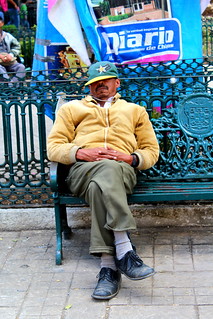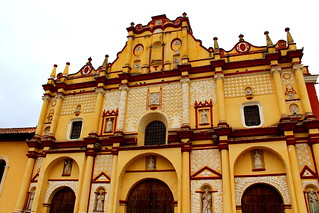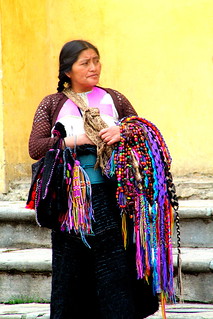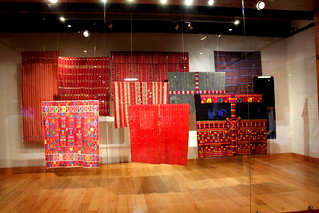There is so much to see and do in the city of San Cristóbal de las Casas. We were constantly on the go for the 5-days we were there  and didn’t have time to complete even our edited short list of must sees but here is a brief report on places we did manage to see around the city.
and didn’t have time to complete even our edited short list of must sees but here is a brief report on places we did manage to see around the city.
Any discussion of city sights in San Cristóbal should begin with the Central Square. Technically the name of the square is Plaza 31 de Marzo, but most simply call it The Square or the Zocalo. In the center there is a large gazebo with a stage surrounded by gardens, trees and benches. In addition the Square is a market place for mostly women vendors from nearby villages selling textiles, bracelets and belts; some with small displays but most simply walking from tourist to tourist. 
It should be noted that most of the tourist are Mexican Nationals. While it probably will be “discovered” at some point in the future, San Cristóbal does not see anywhere near the number of gringo tourists as some other parts of Mexico.
The Central Square is also bordered with some of the most important buildings in the city. High on that list is the Cathedral. The main entrance and most impressive facade of the Cathedral actually faces its own plaza, which while we  were there was typically occupied by a protest (complete with structures) of the mistreatment of indigenous people on most days but filled with tents selling pastries during the celebration for the Virgin of St. Carmen festival. It is actually the side of the Cathedral that faces The Square.
were there was typically occupied by a protest (complete with structures) of the mistreatment of indigenous people on most days but filled with tents selling pastries during the celebration for the Virgin of St. Carmen festival. It is actually the side of the Cathedral that faces The Square.
Attached to the Cathedral is the smaller 17th Century San Nicolás Temple church built in the Moorish style with very little exterior ornamentation that was originally constructed for worship by African slaves and indigenous peoples. 
On another side of the square is the Palacio de Gobierno or city hall, a 19th Century Neo-classical structure fronted with a covered corridor. We didn’t actually visit the inside of the Palacio so can’t be of much help in describing it. There are lots and lots of impressive churches in San Cristóbal; 19 to be exact according to a very helpful young cab driver who named all 19 for us one evening.
One of the churches we visited was the Church and former Convent of Santo Domingo (Iglesia Ex Convento de Santo Domingo.) In fact we visited the area of the city it is located several times as it not only had this beautiful important church but home to several important locations for anyone with an interest in textiles.
On the second floor of the church building is the Centro de Textiles del Mundo Maya with a very impressive collection of over 500 hand woven  textiles with an emphasis on Chiapas huipiles and tunics but with examples from all over Mexico and Central America. If you make a visit there, be sure to pull out some of the many drawers below the displayed exhibits for additional striking examples of the crafts.
textiles with an emphasis on Chiapas huipiles and tunics but with examples from all over Mexico and Central America. If you make a visit there, be sure to pull out some of the many drawers below the displayed exhibits for additional striking examples of the crafts.
While not specific to textiles, the Museo de los Altos de Chiapas is also located inside the Ex-Convento de Santo Domingo. It features Maya archaeological relics from the region including some items from ancient settlements near the modern city of San Cristóbal.
While there are a few remnants of ancient textiles in the Museo de los Altos de Chiapas, on the grounds of the Church you will find some excellent modern examples of the best in Chiapas weaving at Sna Jolobil Cooperativa. Sna Jolobil translates as House of the Weaver and this showroom displays some beautiful textiles made in 20 regional Tzotzil and Tzeital communities including San Juan Chamula, San Lorenzo Zinacantán, San Andrés Larráinzar, Magdalena and Tenejapa.
Tenejapa is the home of María Meza Girón who along with her son Pedro Meza and Chip Morris the author of Living Maya Handmade and the Bible for Chiapas textiles: Guide to the Textiles of the Chiapas Highlands were the founders of Sna Jolobil. The quality of the pieces in this showroom are excellent and by buying there, you’ll know that virtually all of what you pay will go to the weaver but we did notice that prices were slightly higher than we saw for similar items of similar quality when we visited the weavers in their home villages.
For those looking for less expensive but still well-crafted textiles, stalls for vendors selling local as well as regional (including Guatamala) textiles start just off the entrance to Sna Jolobil and run across the front of the grounds of the Ex Convento de Santo Domingo and spill down the stairway onto the city streets.
Orquídeas Moxviquil – Botanical Orchid Garden began in 1994 as a private effort to save orchids and other epiphytes, which were being lost as habitat was cleared for development. In 2007 it eventually evolved into Jardín de Orquídeas Moxviquil at PRONATURA’s Moxviquil reserve on the outskirts of San Cristóbal. Unfortunately, on the misty day that we visited, the green house was closed but we enjoyed a walk around the grounds and saw a portion of 5,000 plants on the grounds that are divided into 3 environments. From the Central Square, our cab ride cost $55 pesos (about $3.50 USD). We had a short wait across the street to catch another cab, which took us to Casa Na Bolom, our next stop of the day for $35 pesos.
Casa Na Bolom was the home of archeologist Frans Blom & his wife, the documentary photographer Gertrude Duby Blom. Today, Na Bolom operates as a hotel, museum, and research center dedicated to the protection of the Lacandon Maya and the preservation of the Chiapas rain forest
A visit to well-respected healer Sergio Castro’s collection of regional costumes at his Museo de Trajes Regionales is a great way to see a large number of complete outfits of the Highland Maya. The collection includes antiques as well as clothes still in daily use in many communities and others reserved for ceremonies and special events. The clothing has been accumulated over the years as donations by a community of grateful patients who come for treatment of burns at no cost.
In a near perfect symbiotic relationship, Sergio uses the donations by those touring the Museo to fund his healing practice. When we visited he was very generous with his time providing lots of information as he walked us around this wonderful collection located in his home. You will need to call ahead to make an appointment. Tours usually start at 6pm and last about an hour. The museum is not well marked by any sign but is located at Guadalupe Victoria 38. Just look for the doorway with the number 38.
Walking Streets – walk along Real de Guadalupe, taking in the city’s pedestrian street before reaching the Church of Guadalupe up a steep flight of steps. Not only is the church fascinating with its neon lit picture of the Virgin, but from up at the top you can see across the whole city and over the mountains. The view is certainly worth the climb!
Other Pages on our visits to San Cristóbal de las Casas
Tenejapa
San Juan Chamula
Magdalena
San Andrés Larráinzar
San Lorenzo Zinacantán
Restaurants – San Cristóbal
Hotel San José
